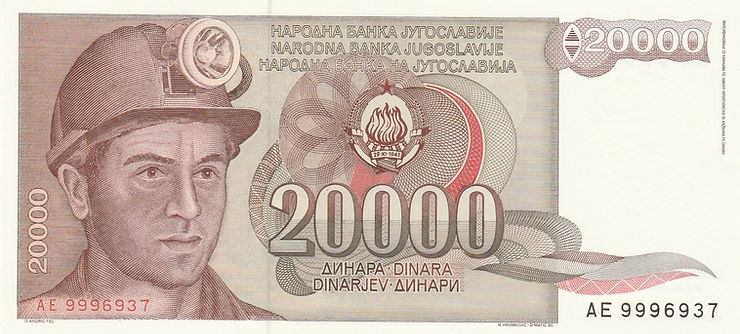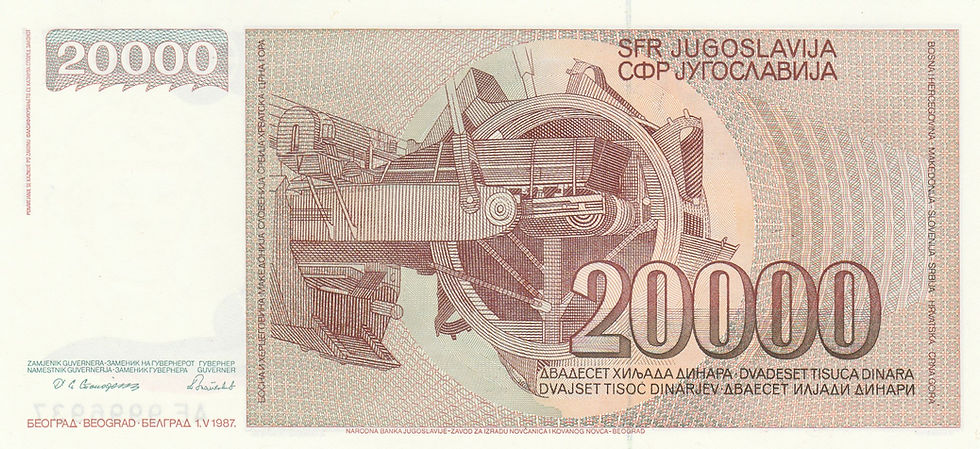This Yugoslavian banknote represents the 9th denomination of the “Hard Dinar" (2nd, Series 1985).The Hard Dinar represented the first post-WWII attempt to re-stabilized the Yugoslavian Dinar. By standardizing exchange rates between the Yugoslavian Dinar and foreign hard currency. Although despite this, it's history was plagued by a number of political events.
The first being the Nixon Shock (1971), which lead to the "Hard Dinar to de-peg from the US Dollar. Followed the 1980 death of Marshal Josip Tito (1892 -1980), further worsening the political and economic situation. On 1 January 1990, the the Convertible Dinar replaced the Hard Dinar.
Observe

The observe features a portrait of miner Alija Sirotanović (1914-1990), Hero of Socialist Labour. Who was popularly known from a state propaganda story. In which, his crew mined 152 tons of coal, within a single shift. Reputably, when asked for a reward by Marshall Tito. He only requested a bigger shovel. This is the only variant of this portrait, it was not reused on later banknotes series.
At the note's center is the 1963 Emblem of SFR Yugoslavia, featuring 6 torches. These torches are a metaphor for the 6 republics of SFR Yugoslavia. Above is multilingual text in Serbian, Croatian, Slovenian, and Macedonia. All which translates to the "National Bank of Yugoslavia". The 1st/2nd letters of this text aligns, with a faintly visible security tread.
Below the SFR Emblem is a large number "20000" and quad text, stating the notes 20,000 Dinara face value. An additional vertical number "20000" can be seen, at the left of the portrait. Toward the note's right is the watermark area. It features a mirrored image of the note's portrait.
At the top of this watermark area is a number "20000", on a decorative "bulbous" design. Notably the shape of this design varies, based on the note's portrait. To the far right is vertical text in Serbian and Croatian, it translates to "Forgery is punishable by law", a warning to counterfeiters. Below on the note's lower corners are dual-serial numbers, "AE 9996937".
Reverse

The reverse depicts a bucket-wheel excavator, used for strip mining. Just as the observe, the reverse features miltilingual text. Above the illustration the text simply translates to "SFR Yugoslavia". While below is a large "20000" and additional text, representing the note's "Twenty Thousand Dinara" value. Printed in Serbian, Croatian, Slovenian, and Macedonian.
The reverse watermark area features Slovenian and Macedonian text, on its counterfeit warning. The number "20000" is backed by a different design, that is "saw" shaped. The serial number has been replaced by the text in all 4 national languages. With signatures, representing the Bank Governor and Deputy Governor. The text below states this note was printed in 1987, at the city of Belgrade (Beograd).
At the note's footer is fine text, it reads "Narodna Banka Jugoslavije-Zavod Za Izradu Novčanica I Kovanog Novca-Beograd". The center section represents the note's printer, commonly known a ZIN. The last section refers to Belgrade, were ZIN is headquartered. While the first section refers to the notes being approved by the National Bank of Yugoslavia.
Hard Dinar Gallery
(Gallery will be updated as more banknotes are databased)
Additional Notes
This note's dimensions are 170 x 77 mm or 6.69 x 3.03 in, larger than a US Dollar.
The preferable method to preserve this note are standard sized protective sleeves.
The Hard Dinar ISO code was YUD, it used both din. and дин as symbols.
The Hard Dinar was subdivided into 100 Para, coins were in Para and Dinar values.




























Opmerkingen